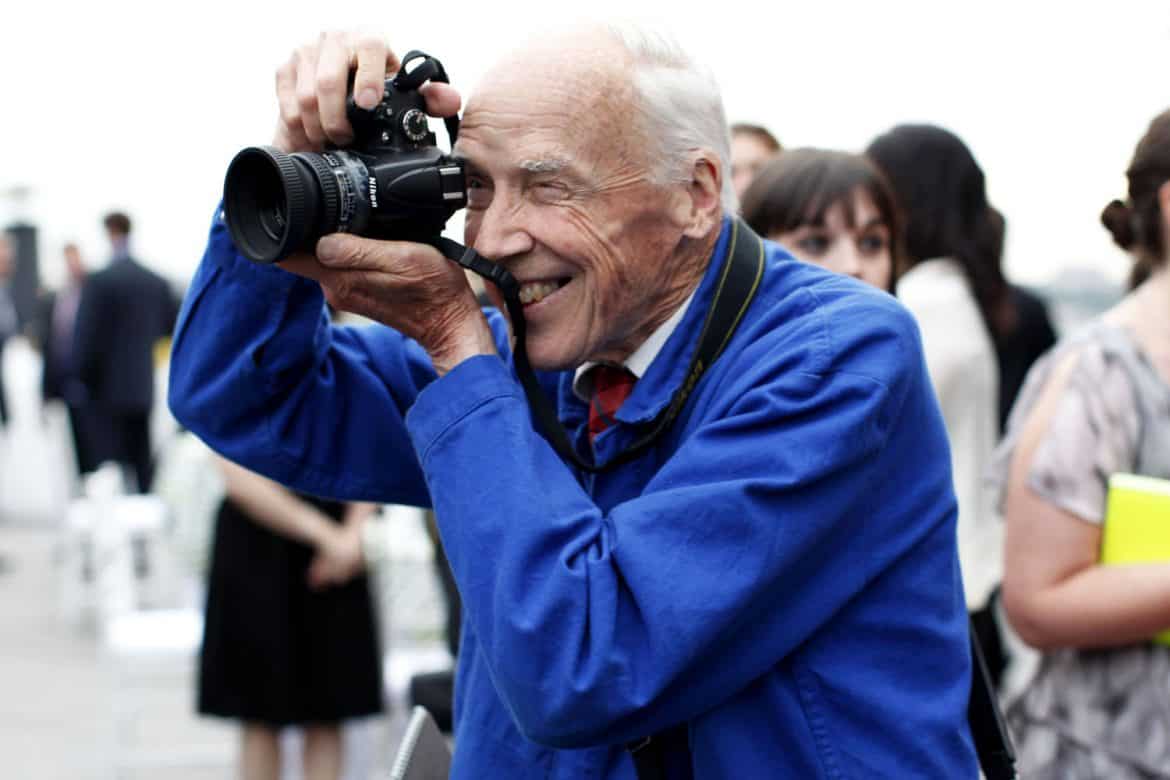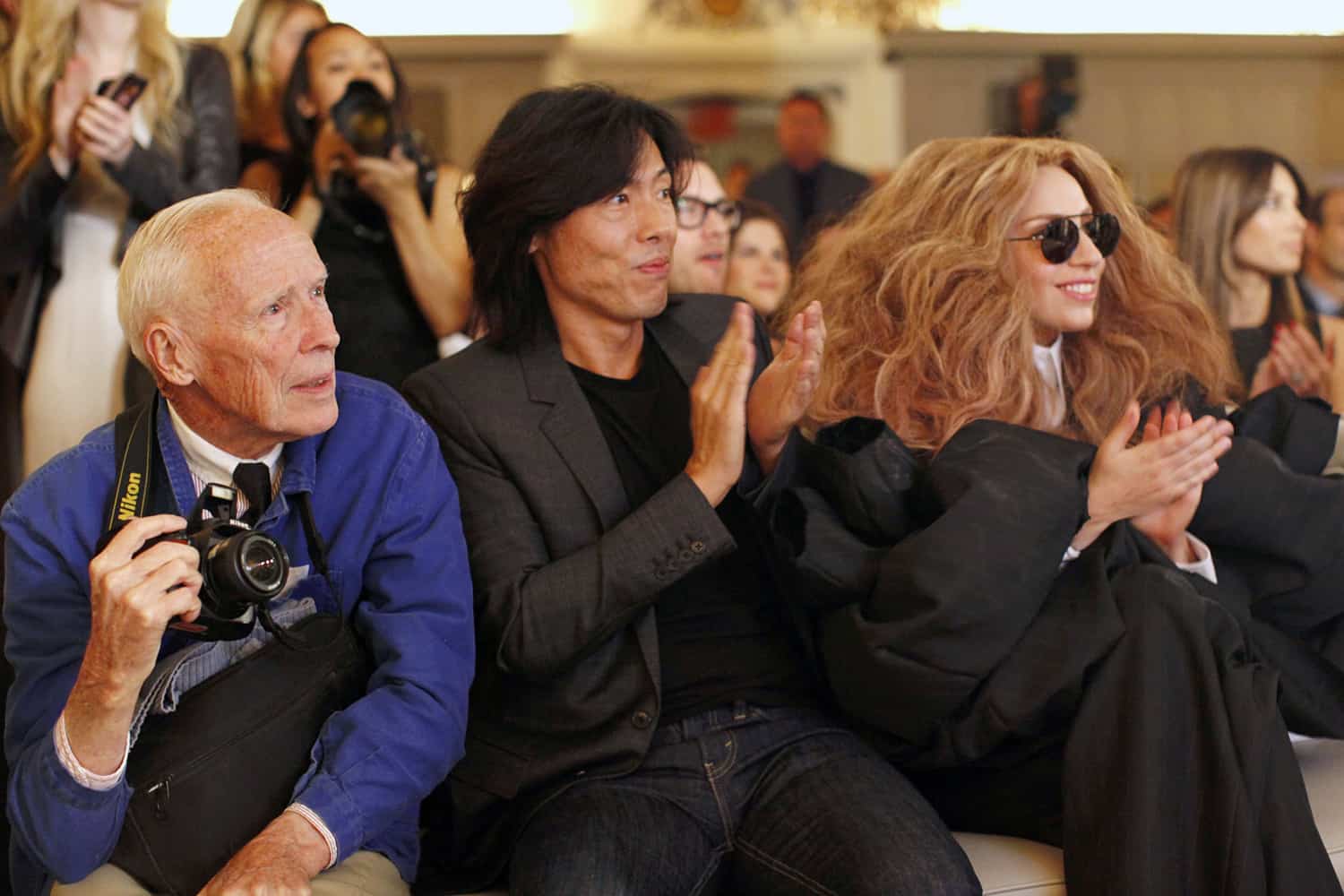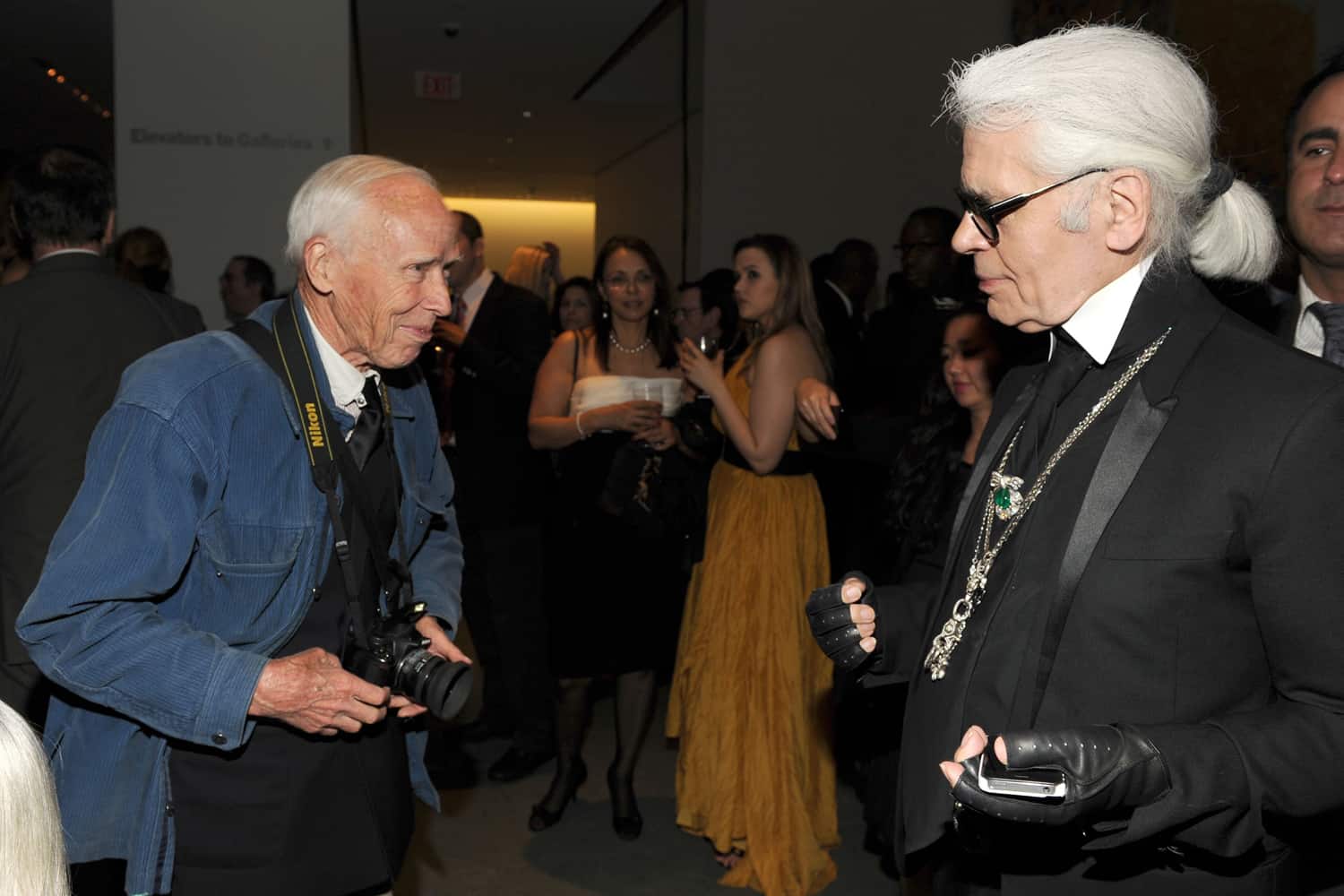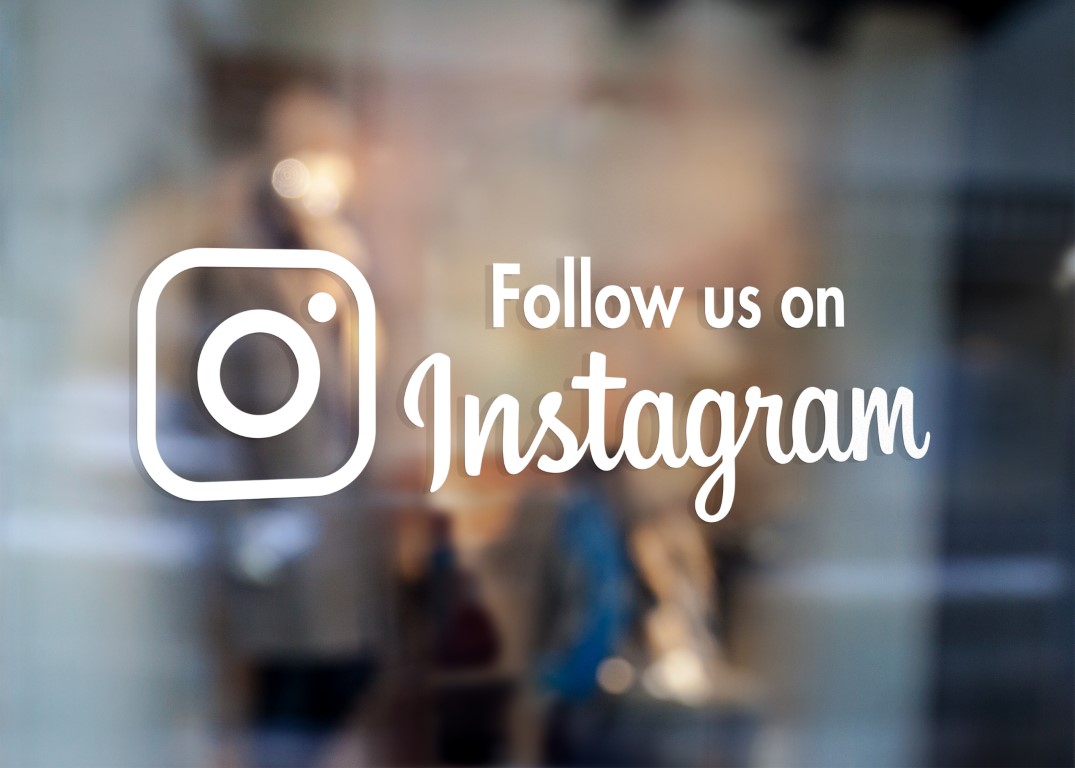CHIC REPORT: THE UNTOLD STORY BEHIND THE NEW BILL CUNNINGHAM DOCUMENTARY
In 1994, Mark Bozek landed the interview of a lifetime: a three-hour chat with Bill Cunningham. For the first — and only — time, the legendary photographer opened up and got personal on-camera. Now, Bozek is making parts of the interview public, through his documentary, The Times of Bill Cunningham. Last week after a premiere in New York, The Daily called Bozek to discuss the film. From using a network of Cunningham’s friends to piece together parts of his life, to exploring his previously unseen archives, the director fills us in on how the project came together.
When did you first become interested in interviewing Bill Cunningham?
I had a series called Fox Style News. One of the first stories I wanted to do was on Bill. The first time I asked was a very polite “No young fella, I don’t do that kind of thing.” But I asked him [four] more times. I remember later saying, “Let’s try to do this anyways.” For the next year when doing other stories, we’d see Bill on the street or at an event, and the guys would discreetly pick up the cameras and shoot footage of him. When I had enough I interviewed Bill Blass, James Galanos, and Liz Smith, the gossip columnist, and ran the piece in December, 1993. It was a nice three-minute story about Bill. I was happy I did it. There hadn’t been any stories about him like that at all.
So how did you finally land the interview?
About two weeks in [to my new job at QVC], I get a phone call from Bill. He said, “Young fella, I hate to bother you, I didn’t see your story. I don’t have a TV. But I have to accept this award. Would you mind coming over to my studio to interview me to produce this one-minute video to play on stage?” I got a crew together and went to his studio. There was no place to set up the camera, so we went to his best friend’s apartment a couple floors down. I thought, I’ve got 10 minutes. I gotta get a couple of sound bites and that’ll be it. But 30 minutes later he kept talking. I was young and inexperienced, but I realized that I should be quiet and just let him. We really did run out of tapes to use because I [only] brought enough to do a couple of sound bites. Luckily, we had some extra.
Do you have any theories as to why he chose to open up?
I only have theories based on other what other people have told me… he liked the fact that I wasn’t a fashion expert. I was certainly not Barbara Walters for 60 Minutes. Although when he started to get upset that first time out of the blue, just talking about how shy he was, I had this moment like, Oh my God, I made Bill Cunningham cry! I just need a couple of sound bites and now he’s crying. But they all say it’s because he just felt comfortable. And I think likely, because of his passion for documentation, that he decided on that day he was going to verbally document his life.
Were you conflicted at all about including the scenes of him being vulnerable?
At the end of the day, you want to make a film that shows your character in all it’s different forms. I can’t say I was totally conflicted, because I wanted to treat it respectfully. But what he was saying was so important, and he never said “turn off the camera” once. We turned it off a couple of times because it was too much. So many people that have seen the movie are emotional because of what he talks about. How the AIDS crisis was throttling the industry and the country at that time. I worked for Willi Smith, who died of AIDS in 1988, for seven years. So I knew the effect of that. It was something that he wanted to talk about.
Cunningham, Steven Gan, and Lady Gaga at The Daily Front Row’s Fashion Media Awards (Clint Spauling/PMC)
So what did you do after shooting that footage?
I put it in my basement and didn’t touch it until the day he died, three and a half years ago. On social media, everybody heard that Bill passed… it was a really sad couple of days in New York. I said to my son, “Let’s go in the basement and find those tapes that I did with Mr. Cunningham 23 years ago.” I found the old beta tapes and had them bumped up to a digital file. That was the first time I’d watched them in 23 years. It was really emotional, because he had just passed and he’s so full of life in this interview — so many different spectrums of emotions. It really touched me.
You held a screening of all three hours of footage for a close group of Bill’s friends. What was that viewing like?
They were stunned that Bill opened up as he did, because they’d never seen him open up like that. Certainly not on camera. Obviously, personally [he did]. Ruben and Isabel Toledo would have dinner with him almost every Saturday night for years at a little cheesy diner by Carnegie Hall. We spent another hour or so just talking about it. It was very emotional for a lot of them because it was just six months [after he passed]. I remember asking them, “What do you think? Do you think I should go forward?” They all said, “You must do this!” And then relentless emails from particularly Ruben and Isabel — “How’s it going? What’s happening?” — it was great.
Did they have anything to add to the process?
They helped me fill in the blanks on a lot of holes of people I didn’t know that Bill talked about. Particularly Chez Ninon [the boutique he was employed by]. They could connect me to this person and that person. It began this process that I had no idea was going to take three and a half years to finish. But, especially now, it’s the greatest feeling in the world. After all that work, having Ruben do the artwork for the film, having Pat Cleveland let me use her song “Tonight Joséphine” during the credits. And of course having [narrator] Sarah Jessica Parker say yes before she even saw one frame of the film.
The film includes decades worth of his photos. How did you get your hands on them?
I didn’t have any access to Bill’s pictures until I met his niece, who owns the archive. That began a whole new process of showing her the footage at this Holiday Inn up in Orangeburg, where the archive is stored. She was she was very emotional, weeping hysterically after seeing it because she had never seen her uncle talk like that. He kept those worlds of his very separate. They just knew he was a photographer. So she gave me access to the archives.
What was that like?
The first day there I was like a kid in a candy store, to say the least. Having lived with this footage for a year and a half and now being able to go in and find the pictures of Diana Vreeland, every time her hand touched a mannequin for 11 years times two weeks; the gay pride parade pictures which he had never published; all the Jackie Kennedy pictures. Those things were just remarkable and they actually let me bring boxes of the archive to my home on Long Island. I turned my dining room into this massive scanning operation.
Wow! That’s amazing.
We immediately bonded because she liked the film and she knew that I wasn’t going to do anything untoward, or dishonest, or take advantage of [his legacy]. She loved it. She was at the premiere. And it was incredible being able to celebrate with her, because she’s been so gracious. I ended up, of the three million images in his archives — and documents, tape recording, you name it — scanning about 25,000 of those images, and then 500 or so ended up in the film.
You could have easily made a film just about him documenting the early years of the Met Gala or the history of the Pride Parade. Why did you edit the film chronologically?
From day one, I wanted to make it into a feature documentary. I had talked to other people about doing it as a series. That may eventually still happen. The picking and choosing of what I thought were going to be the most effective stories was really based on the stories Bill told us. The interview you see in the film is not in sequential order because Bill was jumping from one era to the next. It would be confusing if I did that, so we created a timeline. The part that took the longest by far was editing the pictures. I wanted to do what Bill did: be selective about every single picture in the movie like he was very selective about every picture that would be in the Sunday Times.
Was there anything you discovered in your research that you didn’t include in the documentary?
Bill was a documentarian and he saved everything. When the women from Chez Ninon passed on, he saved all their stuff. In the Chez Ninon box was a box of receipts of all the clothes they made for Jacqueline Kennedy, Brooke Astor, and Rockefeller. I went to the Jacqueline Kennedy file and there was the receipt for the pink dress that she wore to Dallas. It’s likely one of the most famous dresses in history, certainly in American history, because of all the attachment to it to the president being assassinated. And there was this receipt with a little pink swatch.
What do you think will stand out the most to viewers?
His treasure trove of an archive will go down as one of the most important in the history of New York City. Not just fashion, but society. He took pictures every single day since 1967. The other thing was his unbelievable humility, that somebody could be so revered and treasured by everybody in the fashion industry, and yet live on cheese sandwiches and oatmeal in a tiny space that didn’t have a bathroom (he shared with everybody on the 12th floor). Lastly, his incredible generosity. Buying Antonio Lopez’s painting [for $130,000] when Antonio had AIDS, and then giving the painting back so he could sell it again. He had diamonds in a pillowcase stuffed away in his cave at Carnegie Hall. That surprised a lot of people because he would never, ever share that with anybody. He was too discreet.
What are you hoping this documentary will add to his public memory?
I never ever set out to make a fashion movie. I was much more intrigued by his character — his sometimes contrarian character… Ruben said, “This should be in the National Archives” because it’s him full of life, telling a story that had to be told. There will be other stories about Bill. There will probably be a feature film about him. I think they’re going to name buildings after Bill Cunningham, build statues of Bill Cunningham. I hope the fashion world sees what an original character he was. There will never ever be another Bill Cunningham again, no matter how many followers a photographer has on Instagram.
What’s missing from how fashion is communicated these days on social media?
A knowledge of history. Understanding how things were cut and how different designers had an effect on [each other]… Nobody will be as wise as he was in terms of fashion history and his ability to remember things back to the ’30s… I don’t want to necessarily give Diet Prada a plug, but those two people know fashion history in ways that blow my mind. They’re the closest to come to at least having the knowledge. But that’s what’s really missing. I want young people to see this guy who, up until a week before he died, was out there working every single day, and so passionate about his work.
The Times of Bill Cunningham is playing in select theaters.









